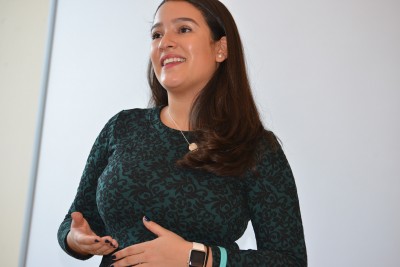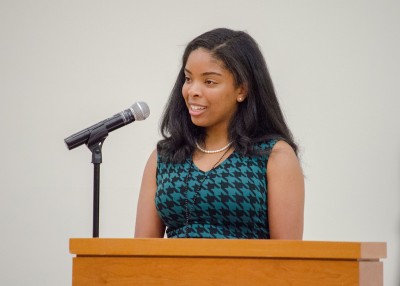Growing up in New Canaan, Conn., aspiring educator Lexi Bodick ’16 (ED) attended public school, where she says she learned from white teachers alongside her predominantly white peers. While classmates playfully referred to Bodick as “exotic,” as she identifies as half-white, half-Mexican-American, Bodick says she felt that the absence of classroom diversity stifled her Mexican-American identity, allowing only the “white part” of her to shine through.
“Representation matters,” she says. “[At New Canaan High School], I didn’t get to have those personal interactions with others of color, so I wasn’t able to share and relate as much.”

Now a senior music and music education major in the Neag School, Bodick says UConn has not only exposed her to a wide range of people and experiences – but also inspired her to get involved with fellow students of color, encouraging them to consider becoming educators, too, through a student organization called Leadership In Diversity (L.I.D.). Bodick was one of the organization’s original members, along with IB/M curriculum and instruction student Tracey-Ann Lafayette ’15 (ED), the founder and current president.
The primary objective of L.I.D., Lafayette says, is to give students a place to discuss diversity issues that surface in the classroom – conversations that can be difficult to have.
“At UConn, people aren’t always comfortable having conversations about diversity. We need to find out how can we get to a place where people are comfortable with being uncomfortable,” Lafayette says. “L.I.D. works to promote these conversations.”
In addition to holding discussions on diversity issues, L.I.D. works with Neag School faculty advisors and academic advisors who help the organization’s members with school and job application processes, and hold workshops to coach students on developing strong interviewing skills. These initiatives aim to increase confidence among UConn’s students of color in reaching their academic or career goals in the field of education – whether that be acceptance into the Neag School of Education, pursuit of graduate school, or a first-time teaching job.
In Connecticut, student diversity is rapidly increasing while the level of diversity among teachers remains stagnant. Nearly 40 percent of Connecticut students are of color, compared with just 8 percent of the state’s teachers.
‘A new world of possibilities’
Faculty advisor and assistant clinical professor Mark Kohan says an important part of L.I.D. is recruiting students of color to education programs. This is especially vital in Connecticut, where student diversity is rapidly increasing while the level of diversity among teachers remains stagnant. Recent data from the State Education Resource Center indicates that nearly 40 percent of Connecticut students are of color, compared with just 8 percent of the state’s teachers. Meanwhile, Connecticut has one of the largest achievement gaps in the nation.
Teachers of color can enhance success for both white and nonwhite students, Lafayette says. For instance, learning from nonwhite teachers is an opportunity that allows white students to foster positive relationships with people of color. For students of color, research has found that teachers of color tend to hold them to higher standards than do white teachers. At the same time, teachers of color may serve as an inspiration to their minority students.
“It’s helpful for students to see, ‘Here’s someone who looks like me, so I can do this, too,’” Lafayette says. “It opens up a new world of possibilities.”
L.I.D. members are actively working with the Neag School academic advising team to boost diversity in the school of education’s student body. The process of encouraging students of color to become teachers now extends to the high school level, with visits to local schools by the academic advising team and on-campus partnership events that the Neag School academic advisors help facilitate in collaboration with L.I.D. The team also holds recruitment sessions offered at each cultural center on the Storrs campus and all four regional campuses. The admissions process, especially that of the IB/M teacher education program, has been altered as well, with deadlines to submit scores for the PRAXIS exam – the assessment required for entry into the teacher preparation program – having been pushed back. PRAXIS Core study groups, intended to support students in successfully passing the exam, are also being held by Neag School academic advisors Dominique Battle-Lawson and Mia Hines. Kohan says this allows for all students, particularly minorities, to have sufficient time to prepare their best application possible.

“The Neag School is high-achieving, but there are many ways to attain this [level of achievement],” Kohan says, adding that recruiting a broader spectrum of teacher education students could yield equally successful results for both Connecticut students and the state’s teacher administration.
Partnering With the Neag School
Since L.I.D.’s inception in 2014 the organization has filled its calendar with noteworthy events and activities. This past fall, L.I.D. members traveled to New Orleans to partake in the National Association for Multicultural Education (NAME) Conference. The representatives from UConn gave a presentation regarding how to “create a pipeline” for students of color in teacher preparation programs.
In addition, L.I.D. teamed up with Neag School faculty and administrators in November to host a Day of Learning, Leading, and Lighting the Way for Equity and Social Justice. The event was a professional development opportunity for students, faculty, and staff, featuring guest speakers Bree Picower of Montclair State University and Antonio Nieves Martinez of the University of Massachusetts-Amherst. Picower and Nieves Martinez led workshops on equity, social justice, and the art of creating inclusive environments in the classroom and beyond.
Bodick secured $2,000 in Undergraduate Student Government funding for the event, which the Neag School Dean’s Office matched. She says the event would not have been possible without cooperation between L.I.D. and the Neag School.
“It was definitely a student, faculty, and staff event,” Bodick says. “We’re working toward greater collaboration [with the Neag School]. This partnership is key to L.I.D.’s success.”
The organization’s next major project is a student-and-professional mentoring program. Educational professionals will mentor pre-teaching and current undergraduate students in the Neag School IB/M Program. Currently, L.I.D. has 47 practicing teachers, administrators, and University faculty and staff who have agreed to serve as mentors, and 40 student mentees. The mentoring program – called Diverse Educators Making Outstanding Change (D.E.M.O.) – kicked off last month with an event that offered participants an opportunity to discuss the goals of the program and engage in small-group dialogue over dinner.
“Once we set the groundwork for this program, we’ll have professional relationships we can continue and grow,” Lafayette says.
In seeking to grow their relationships with current teachers, L.I.D. members are also strengthening their connections with students at the elementary- and secondary-school level through student teaching. Bodick, an aspiring music teacher, began student teaching last fall. In high school, she was the bass player in the onstage band for the Broadway show “13 The Musical.” She says this experience gave her a nontraditional and more culturally relevant education in music, something she hopes to relay to her future students.
“I want to change the reality of music education,” she says, “and make it more relatable to students.”
 Facebook
Facebook
 Twitter
Twitter
 LinkedIn
LinkedIn
